The death of old Dewey Bridge on April 6, 2008, burned to death by a seven year old playing with matches, was almost more bad news than I could bear to hear. As one relic after another of the rural West’s past vanishes, this was one remnant I thought would survive. It was just a few years ago that Jennifer Speers, the millionaire with a soul, bought up the adjacent Dewey Bridge subdivision from a developer, plowed under the roads, dismantled the infrastructure and tore down a $600,000 home in order to restore the area to the way it had been.
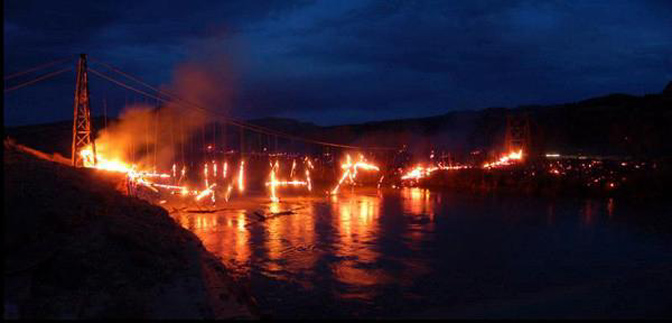
It was a rare place of Hope. Unlike the rest Southeast Utah, maybe this little piece of Paradise and history would stay the same. Then this. The fire triggered memories of my first visit to Dewey, more than 30 years ago.
I first heard about Dewey Bridge, believe it or not, from my mother. In 1973, I was still living in Kentucky, trying to scrape together enough money to come West again, if only for a month or so. The previous winter, I’d passed through Moab for the first time, on one of the coldest days in recorded history. With a can of flaming Sterno on the floorboard of my VW Squareback (the damn heater never worked), I stopped only long enough to gas up and then drove all the way to Grand Junction, where I used my dad’s Gulf Oil credit card for a warm bed at the Holiday Inn.
But I’d seen enough of this country to plan a return visit under better conditions. I’d hoped to leave in July for SE Utah, but my parents had booked a raft trip down the Colorado River through the Grand Canyon with their friends, Bill and Vera Parker, and they asked me if I’d stay at their farm and keep an eye on the place. In exchange, they offered to help me out with gas money when I came West in August.
When they arrived home, I was eager to hear of their adventures on the river, and they had plenty to tell. But the highlight of their trip, it seemed, had been a 50 mile drive down a Utah back road, a dusty unpaved, corrugated “highway,” designated State Route 128. And they told me of a one-lane suspension bridge, Dewey Bridge, that crossed the river 30 miles upstream from Moab.
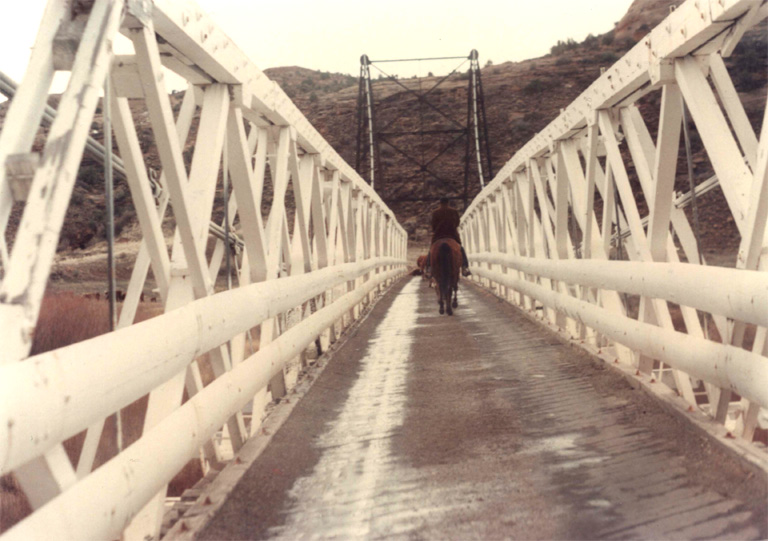
Bill Parker was the kind of guy who’d turn down a dirt road in a Buick and never wonder if he needed high clearance or 4 wheel drive. When they exited I-70 in the middle of the Cisco desert and the pavement ended and it looked as if the route was descending into the dusty bowels of a very deep canyon, my parents thought he was crazy.
But Bill’s joyful enthusiasm and love for the canyon country was infectious. They found Dewey Bridge, tucked away safely from most of the world since 1916, paused briefly to admire the bridge and the canyon, and reached Moab by afternoon.
Weeks later, when they came home to the farm, and my dog Muckluk and I prepared to leave, my mom gave me very careful directions—it was the first exit to Cisco, not the second, she insisted. Look for the dirt road on the left, a couple miles west of the town.
I followed her directions and, incredibly, they were accurate (my mother has never been known for her navigational skills). We passed through Cisco—there was one café still open then, Ethel’s I later learned, but didn’t stop. Just as my ma had predicted, I spotted the gravel and dirt road, Utah 128, and turned left toward the river. I saw no one. Not a car or motorhome. No trucks or RVs. No ATVs. Nothing.
We came to the river, my dog and I, and figured the bridge was just ahead, but it was late afternoon, so I pulled into a stand of cottonwoods to make a camp. I pitched my cheap little blue nylon tent, fed Muck, cooked some beans on my Coleman stove and walked over to the Colorado to eat. The river was low, but the current was swift. I saw a Great Blue Heron, heard other birds whose songs I could not identify. And I could hear the rustle of the leaves in the great cottonwoods above me.
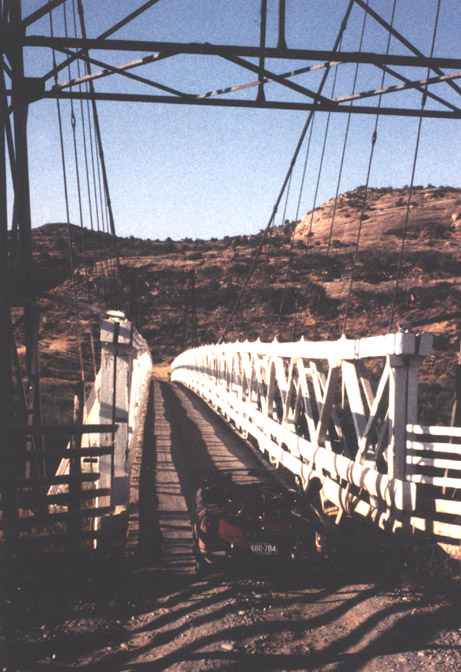
Finally, as the canyon filled with shadows, I heard the whine of a motor, coming down the grade from Cisco. It was a pickup truck, a local rancher I guessed. He saw me and waved and kept going. I could hear his truck for a few minutes and then the silence returned.
That night was one of the happiest of my life. An evening of “quiet exaltation” as someone once said.
The next morning, I found the bridge, just where my mom said it would be. We stopped for a while, Muckluk jumped in the river for a swim so she could later smell up the upholstery on my car. It was a glorious morning.
Dewey Bridge was an amazing piece of architecture. It was a narrow (one lane) suspension bridge, constructed in 1916, and for years was the longest suspension bridge west of the Mississippi River. If I recall, its singular title fell when the Golden Gate Bridge was completed in the 1930s. It was a very narrow bridge, constructed for wagons more than cars, and for decades that fact helped to keep traffic on Hwy 128 to a minimum. It was just barely wide enough for a motorhome but if the RV started to rock sideways at all, it would smash the sides of it on the bridge’s wooden infrastructure. Most tourists chose the other longer route.
Anyway, after my discovery of Dewey Bridge I knew it would be the first of many visits. It never occurred to me that any of this would change or disappear.
But in 1974, much of the gravel and dirt road from Cisco to Moab was paved, though the asphalt was rough and pitted, and the “improvements” were negligible. Even better, because Dewey Bridge was narrow, it continued to impede the flow of large vehicles, It was one kind of discrimination I could live with and even applaud. For another decade the road from Moab to Cisco remained quiet.
In 1985, however, UDOT construction began on a new bridge, just down river from the old one. And a year later, when it opened, traffic on highway 128 increased dramatically. Further “improvements” have brought still more traffic. Sometimes it is downright congested. Then the BLM, in its wisdom, decided to build a series of official campgrounds wirth hardened surfaces, designated campsites, “comfort stations,” and a whopping fee. Before campers had pitched their tents and parked their RVS randomly and the government hates that kind of chaos and disorder. The BLM insisted it was creating health and safety issues, and so several new official campgrounds, with hundreds of new sites, and quaint names were built. The consequence, of course, was that they attracted even more tourists. It’s a beautiful drive and those discovering it for the first time will still be awestruck, if they don’t mind the bumper-to-bumper traffic. But they’ll never be able to understand just what it felt like on that summer night in 1973. I’m not even sure they’d care to.
///
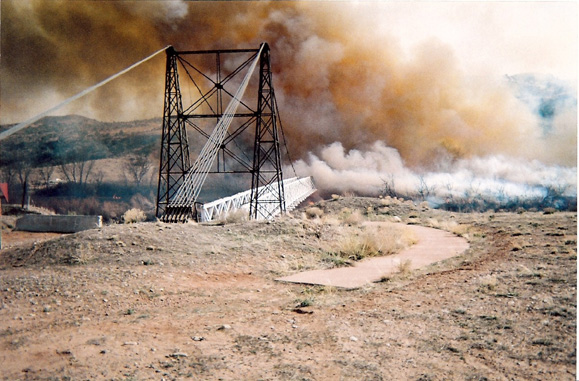
And then came April 6, 2008. A seven year old boy somehow obtained a book of matches and started lighting them near the thickets of tamarisk and will, adjacent to the river. His parets were just yards away, setting up camp. Suddenly a fire erupted and spread quickly.
Marco Leshawn Silva, from Grand Junction, had been four-wheeling with his family when they noticed the brush fire ignite, just 50 yards from the bridge. Strong winds pushed the flames upstream . According to Silva, “the volunteer fire department arrived just as the fire surrounded the south entrance to Dewey Bridge. By then there were about 40 people watching the blaze. Local Law enforcement was on the scene for traffic control. The blaze wiped out visibility on the highway for about 10 minutes. The fire department chose not to attempt to save the bridge.”
Silva later stated his belief that “the bridge could have been saved without casualties, but didnt fault the fire department for being cautious. “We appreciated their response.” Silva volunteered with others to assist the fire crews in the mop up.
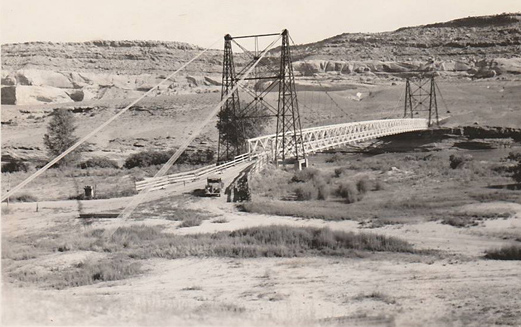
///
A few weeks after the fire, I stopped at the old bridge site for the first time since the fire. I could still smell the ash. The parking lot adjacent to it is now a staging area for mountain bicyclists and on this day, about a hundred brightly clad participants were prepping themselves and their bikes for a ride over the Kokopelli Trail. I felt peculiarly out of place in my Wranglers and Redwings—as much of an anachronism as the old bridge once was. I walked to the south abutment. The fire had burned every sliver of wood; all that remained were the cables. I stood there for several minutes, almost paralyzed by the sight.
One of the bikers walked up to me and said, “Hey I hear they might rebuild it…It’ll be just like it was before.”
I looked at him, smiled sadly, and went back to my car.
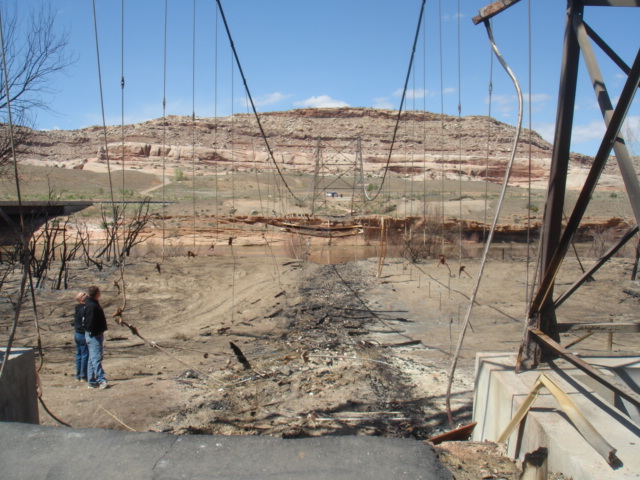
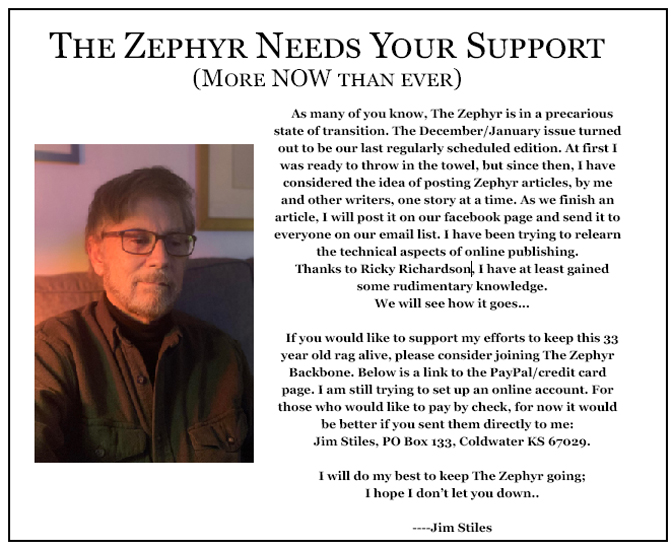



Enjoyed the story of the old bridge. Such a landmark it was and glad you had a niigh with her. You’re doing geat and your readers are not disappointed in the least
Hi Donna…I received your sweet letter recently and plan to respond this week. I was unaware of your own recent loss and hope you’re doing ok. It ain’t easy…I will be writing soon…
As always your stories create good images.
Dear Jim, you could never let anyone down! 33 years of outstanding stories, an impressive collection of work and rich archive for generations to come.
Hi Rachel. Thanks. But there is still a lot of new content coming and some of what I’ve already posted was new as well. And a couple old stories that I’ve recently posted, I was able to go back and do some more research and add greatly to the story. For example, I really never appreciated the Great Love that existed between Toots and her first husband, Dick Wright, who died in a mining accident. You don’t find a mutual love like that very often….Anyway thanks again.
when we first re-located to junxion, we were drawn to your (¿ former ?) part of you-taw. many me(s)moreez of the bridge. i participated in a 4-man bicycle 100-mile team time trail from G.J. to Moab — and that may have been the last time i crossed the bridge. several dirt sections down 128 towards Moab. thanx 4 the synopsis, etc. !
I enjoyed the parting conclusion/comment: it’ll be just like it was before! Fat chance!
As always Jim, well done. My first trip across the bridge was in 1979 so I well remember the days of solitude along 128. Thanks for posting this.